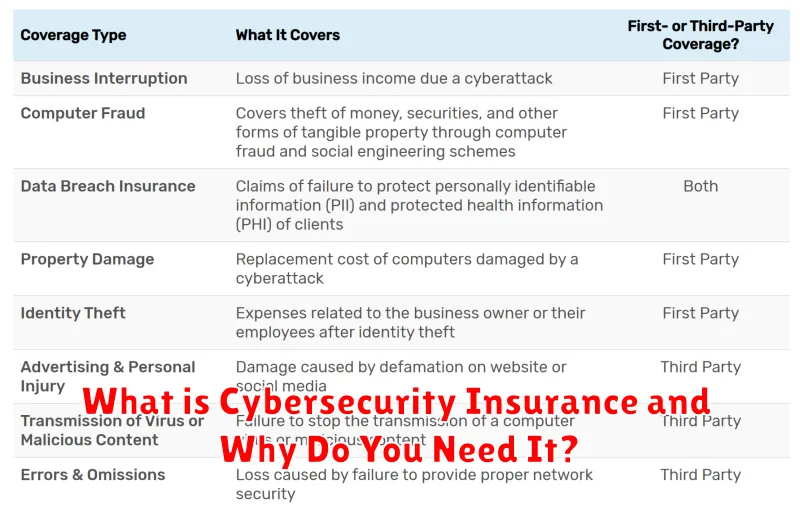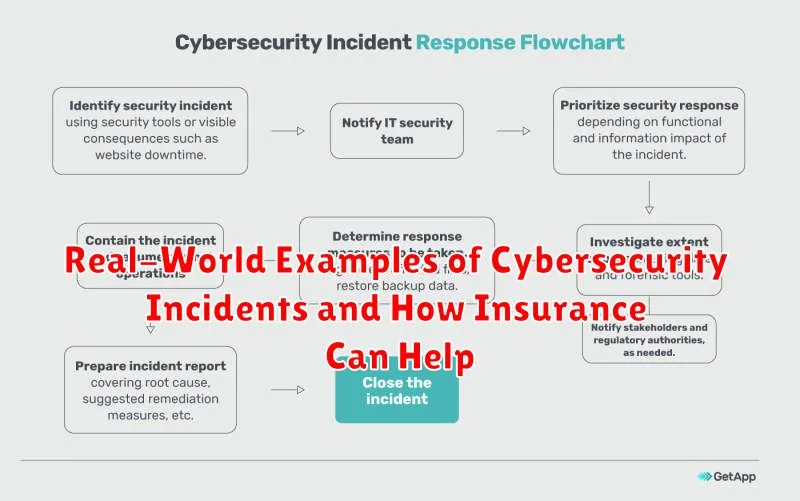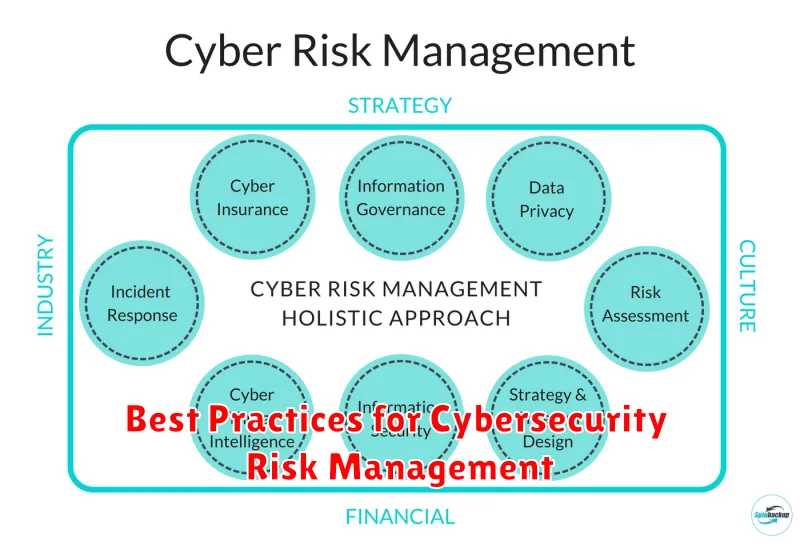In today’s digitally connected world, where our lives and businesses are increasingly reliant on technology, cybersecurity risks have become a significant concern. Data breaches, ransomware attacks, and other cyber threats pose a real and growing danger, potentially leading to financial losses, reputational damage, and legal liabilities. To mitigate these risks and protect your valuable assets, it is crucial to have a robust cybersecurity strategy in place, and that includes obtaining comprehensive cybersecurity insurance.
This guide provides a comprehensive overview of cybersecurity insurance policies, covering essential aspects like coverage options, key considerations, and factors to look for when selecting a policy. Whether you’re an individual, a small business, or a large corporation, understanding the ins and outs of cybersecurity insurance is vital for navigating the digital age and safeguarding your organization from the ever-evolving landscape of cyber threats.
Understanding Cybersecurity Threats in Today’s Business Landscape

The digital age has brought about unprecedented advancements, but it has also ushered in a new wave of cybersecurity threats that businesses must navigate. Today’s organizations are facing a multifaceted landscape of risks, ranging from data breaches and ransomware attacks to phishing scams and malware infections. The ever-evolving nature of these threats necessitates a proactive and comprehensive approach to cybersecurity.
One of the most significant challenges is the increasing sophistication of cybercriminals. They leverage advanced techniques, such as artificial intelligence (AI) and machine learning (ML), to identify vulnerabilities and exploit them for financial gain or malicious purposes. Data breaches have become more prevalent, leading to the theft of sensitive information, including customer data, financial records, and intellectual property. The consequences of such breaches can be devastating, impacting a company’s reputation, financial stability, and customer trust.
Another growing concern is the rise of ransomware attacks. Cybercriminals encrypt an organization’s data and demand payment for its decryption. These attacks can cripple operations, disrupt critical processes, and lead to significant financial losses. Furthermore, businesses must contend with phishing scams, where attackers attempt to trick employees into divulging sensitive information. These scams are often disguised as legitimate emails or messages, making it difficult for unsuspecting individuals to identify and avoid them.
The evolving nature of cybersecurity threats requires businesses to stay vigilant and adapt their security measures. It’s essential to invest in robust security infrastructure, implement strong passwords and multi-factor authentication, regularly update software and systems, and educate employees about cybersecurity best practices. By taking these steps, organizations can mitigate their risk exposure and protect themselves from the ever-present dangers of the digital age.
What is Cybersecurity Insurance and Why Do You Need It?

In today’s digital landscape, data breaches and cyberattacks are becoming increasingly common. Cybersecurity insurance serves as a crucial shield for businesses and individuals, safeguarding them against the financial and reputational consequences of these threats. It offers a comprehensive safety net to cover a range of cyber risks, providing much-needed peace of mind in an increasingly vulnerable world.
Essentially, cybersecurity insurance is a type of insurance policy that protects businesses and individuals from financial losses arising from cyberattacks, data breaches, and other digital threats. It acts as a financial safeguard, covering expenses related to:
- Data breach response costs: This includes costs associated with notifying affected individuals, credit monitoring, legal fees, and forensic investigations.
- Business interruption: Coverage for lost revenue and expenses incurred due to system downtime or disruptions caused by a cyberattack.
- Cyber extortion: Protection against ransom demands and other financial losses incurred due to cyber extortion attempts.
- Cybercrime: Coverage for losses arising from online fraud, identity theft, and other cybercrimes.
- Privacy liability: Protection against legal claims and settlements arising from data breaches or violations of privacy laws.
The need for cybersecurity insurance is paramount in today’s digital age. The increasing sophistication of cyberattacks coupled with the growing reliance on technology makes businesses and individuals highly vulnerable to these threats. Without adequate insurance coverage, the financial and reputational consequences of a cyber incident can be devastating.
Cybersecurity insurance provides a critical layer of protection, mitigating the risks and potential financial burdens associated with cyberattacks. It empowers businesses and individuals to navigate the digital age with greater confidence, knowing that they have a safety net in place should the unthinkable happen.
Key Coverage Areas of a Cybersecurity Insurance Policy

Navigating the digital age comes with inherent risks, and cybersecurity threats are a major concern for businesses of all sizes. Cybersecurity insurance policies offer critical protection against these risks, providing financial assistance and support in the event of a breach. Understanding the key coverage areas of such policies is crucial for making informed decisions and ensuring adequate protection.
Here are some of the most important aspects covered by a cybersecurity insurance policy:
- Data Breach Response Costs: This covers expenses incurred during and after a data breach, including forensic investigations, legal counsel, credit monitoring for affected individuals, and public relations efforts.
- Cyber Extortion and Ransomware: Coverage for ransom demands paid to hackers to regain access to stolen data or systems. Some policies may even cover the cost of negotiating with cybercriminals.
- Business Interruption: This covers lost revenue and additional expenses incurred due to system downtime or disruption resulting from a cyberattack.
- Privacy Liability: Provides coverage for legal costs and settlements related to privacy violations, such as unauthorized access or disclosure of sensitive information.
- Network Security and Hardware/Software Protection: Coverage for the costs of restoring compromised networks, replacing damaged hardware, and reinstalling software following a cyberattack.
- Cybercrime and Fraud: This covers losses resulting from various cybercrimes, including phishing attacks, malware infections, and unauthorized online transactions.
- Crisis Management and Public Relations: Coverage for the costs of managing a crisis arising from a data breach, including public relations efforts to mitigate damage to the company’s reputation.
- Regulatory Fines and Penalties: Some policies may cover fines and penalties imposed by regulatory bodies for data breach violations.
It is essential to carefully review and understand the specific coverage terms and limitations of any cybersecurity insurance policy. Consulting with an experienced insurance broker can help you navigate the complexities of these policies and select the best option for your business needs.
Factors to Consider When Choosing a Cybersecurity Insurance Provider

In today’s digital age, where cyberattacks are becoming increasingly sophisticated and prevalent, safeguarding your business from the devastating consequences of a data breach is paramount. Cybersecurity insurance has emerged as an essential safety net, offering financial protection and support in the event of a cyber incident. However, selecting the right cybersecurity insurance provider is crucial to ensure you have the coverage you need when you need it most.
Here are some key factors to consider when choosing a cybersecurity insurance provider:
Coverage Limits and Exclusions
Start by understanding the coverage limits and exclusions of each policy. Consider the types of cyber threats you are most vulnerable to, and ensure the policy provides adequate coverage for those risks. Look for policies that cover costs associated with data breach response, legal defense, regulatory fines, and business interruption.
Policy Language and Definitions
Carefully review the policy language and definitions. Ensure you understand the terms and conditions, including the definitions of key terms like “cyberattack,” “data breach,” and “business interruption.” Look for clear and concise language that is easy to comprehend.
Claims Handling Process
Investigate the provider’s claims handling process. Seek information about their experience in handling cyber-related claims and their track record of customer satisfaction. Inquire about the speed and efficiency of their claims handling process, as well as the availability of 24/7 support.
Reputation and Financial Stability
Choose a provider with a strong reputation for financial stability and a proven track record in the cybersecurity insurance market. Look for providers with a history of paying claims promptly and fairly. You can research their financial ratings and reviews from industry experts.
Risk Assessment and Prevention Services
Some providers offer risk assessment and prevention services as part of their cybersecurity insurance policies. These services can help identify vulnerabilities in your systems and provide recommendations for improving your cybersecurity posture. Evaluate the value of these services and how they can benefit your business.
Price and Value
While price is an important factor, it shouldn’t be the sole deciding factor. Compare quotes from multiple providers and evaluate the value of the coverage offered. Consider the comprehensiveness of the policy, the provider’s reputation, and the quality of their services.
Conclusion
Choosing the right cybersecurity insurance provider is an essential step in protecting your business from the financial and reputational consequences of a cyberattack. By carefully considering the factors discussed above, you can select a provider that offers comprehensive coverage, responsive claims handling, and valuable risk management services. Remember, investing in cybersecurity insurance is an investment in the long-term security and resilience of your business.
Benefits of Having a Robust Cybersecurity Insurance Plan

In today’s digitally-driven world, cybersecurity threats are a constant reality for businesses of all sizes. A robust cybersecurity insurance plan is no longer a luxury but a necessity to protect your organization from the financial and reputational damage that cyberattacks can inflict.
Here are some key benefits of having a comprehensive cybersecurity insurance policy:
Financial Protection
Cyberattacks can lead to significant financial losses, including data breach expenses, legal fees, regulatory fines, and lost revenue. Cybersecurity insurance provides financial protection to cover these costs, helping you recover from a cyber incident and minimize its impact on your bottom line.
Data Breach Response Services
Cybersecurity insurance often includes access to specialized data breach response services. These services can help you navigate the complex and time-consuming process of handling a data breach, including incident response, forensic investigation, legal counsel, and public relations support.
Business Continuity Support
Cyberattacks can disrupt your business operations and lead to downtime. Cybersecurity insurance can help you recover quickly by providing funds for business interruption coverage, which helps cover lost revenue during the downtime and supports the restoration of your systems and data.
Enhanced Risk Management
The process of obtaining cybersecurity insurance often requires you to undergo a risk assessment and implement certain security controls. This process can help you identify vulnerabilities, strengthen your security posture, and proactively reduce your risk of cyberattacks.
Improved Reputation Management
A data breach can severely damage your reputation and erode customer trust. Cybersecurity insurance can help you manage the reputational fallout by providing crisis communications support, public relations assistance, and legal guidance to mitigate negative publicity.
In conclusion, a robust cybersecurity insurance plan offers significant benefits that can protect your business from the financial, operational, and reputational consequences of cyberattacks. By investing in this critical protection, you can enhance your organization’s resilience, minimize the impact of cyber incidents, and navigate the digital age with confidence.
Real-World Examples of Cybersecurity Incidents and How Insurance Can Help

In today’s digital age, cybersecurity threats are more prevalent than ever. Organizations of all sizes, from small businesses to large corporations, are at risk of experiencing a cyberattack. These attacks can have devastating consequences, including financial losses, reputational damage, and even legal repercussions. Cybersecurity insurance can provide much-needed protection in the event of a cyberattack.
Here are some real-world examples of cybersecurity incidents that highlight the importance of insurance:
- The 2017 Equifax Data Breach: This massive breach exposed the personal information of over 147 million people. The company faced significant fines, lawsuits, and reputational damage. Cybersecurity insurance could have helped cover some of these costs.
- The 2017 WannaCry Ransomware Attack: This global ransomware attack affected thousands of organizations worldwide. Hospitals, businesses, and government agencies were forced to shut down operations, resulting in significant financial losses. Cybersecurity insurance can provide coverage for ransom payments, data recovery costs, and business interruption losses.
- The 2020 SolarWinds Hack: This sophisticated attack targeted government agencies and private companies using compromised software updates. The breach exposed sensitive data and disrupted critical operations. Cybersecurity insurance can help organizations respond to such incidents, including incident response costs, legal expenses, and reputational damage management.
Cybersecurity insurance can provide valuable protection for organizations of all sizes. It can help cover the following expenses:
- Data breach response costs: This includes forensic investigations, legal expenses, and notification costs.
- Ransomware payments: This can help organizations avoid costly downtime and data loss.
- Business interruption losses: This covers lost revenue and expenses incurred as a result of a cyberattack.
- Cyber extortion: This protects against threats to expose sensitive data or disrupt operations.
- Cyber liability: This covers legal expenses and settlements for third-party claims.
By understanding the risks associated with cybersecurity incidents and seeking appropriate insurance coverage, organizations can mitigate potential losses and ensure their business continuity. Cybersecurity insurance is a critical investment for any organization operating in today’s digital world.
Steps to Take After a Cybersecurity Breach

A cybersecurity breach can be a devastating event for any business, causing significant financial losses, reputational damage, and legal liabilities. While a comprehensive cybersecurity insurance policy can help mitigate the financial burden, it’s crucial to take immediate steps to contain the damage and recover from the breach.
Here are essential steps to take after a cybersecurity breach:
- Contain the Breach: The first priority is to isolate the affected systems and prevent further damage. Disconnect infected devices from the network, change passwords, and implement temporary access restrictions.
- Investigate the Breach: Determine the extent of the breach, the type of data compromised, and the source of the attack. Engage a cybersecurity expert or forensic investigator to conduct a thorough investigation.
- Notify Relevant Parties: Inform affected individuals, regulatory bodies, and law enforcement agencies as required by applicable laws and regulations.
- Report the Breach to Your Insurer: Contact your cybersecurity insurance provider immediately to initiate the claims process. Provide detailed information about the breach and the steps taken so far.
- Implement Recovery Measures: Restore compromised systems, recover data, and implement security enhancements to prevent future breaches.
- Communicate with Stakeholders: Be transparent with your customers, employees, and partners about the breach and the steps you are taking to address it.
- Review and Improve Your Cybersecurity Posture: Conduct a thorough security assessment to identify vulnerabilities and strengthen your defenses against future attacks.
Cybersecurity breaches can be complex and challenging. Taking prompt and decisive action can significantly reduce the impact and accelerate recovery. It’s essential to have a comprehensive cybersecurity insurance policy in place and a well-defined incident response plan that outlines these steps and other critical actions.
Best Practices for Cybersecurity Risk Management

In the digital age, protecting your business from cyber threats is no longer an option; it’s a necessity. While cybersecurity insurance policies offer financial protection in the event of a breach, a robust cybersecurity risk management strategy is the foundation for mitigating risks and ensuring your organization’s resilience.
Here are some best practices for effective cybersecurity risk management:
1. Conduct Regular Risk Assessments
A comprehensive risk assessment helps identify vulnerabilities and potential threats specific to your organization. Regularly updating and reviewing these assessments ensures your security measures remain relevant and effective.
2. Implement Strong Access Controls
Strong access controls, including multi-factor authentication (MFA) and robust password policies, limit unauthorized access to sensitive data. This minimizes the impact of potential breaches and protects your critical assets.
3. Train Your Employees
Human error is often a significant factor in cybersecurity incidents. Investing in comprehensive cybersecurity awareness training for all employees equips them with the knowledge and skills to recognize and avoid threats. Regular training and simulations are crucial to maintain awareness and reinforce good practices.
4. Keep Software and Systems Up-to-Date
Outdated software and operating systems are prime targets for attackers. Regularly updating your systems and applications ensures you have the latest security patches and mitigates known vulnerabilities.
5. Backup Your Data
Data backups are critical for recovery in the event of a cyberattack or system failure. Implement a robust backup strategy that includes regular offsite backups to ensure data integrity and availability.
6. Monitor Your Network
Proactively monitoring your network for suspicious activity allows for early detection and response to potential threats. Utilize security information and event management (SIEM) tools and intrusion detection systems (IDS) to enhance your monitoring capabilities.
7. Develop an Incident Response Plan
A well-defined incident response plan outlines the steps to take in case of a cybersecurity breach. This plan should include procedures for containment, recovery, and communication with stakeholders, ensuring a swift and effective response.
8. Regularly Review and Update Your Cybersecurity Strategy
The cybersecurity landscape is constantly evolving. Regularly reviewing and updating your strategy to address emerging threats and industry best practices ensures your organization remains protected and ahead of potential risks.
By implementing these best practices, you can significantly reduce the risk of cyberattacks, minimize their potential impact, and strengthen your organization’s overall security posture. Remember, a proactive approach to cybersecurity risk management is essential for navigating the complex digital landscape.
The Future of Cybersecurity Insurance in an Evolving Threat Landscape

The digital landscape is constantly evolving, and with it, the threats that organizations face. This means cybersecurity insurance, which protects businesses from financial losses due to cyberattacks, must also adapt to stay relevant. As cyberattacks become more sophisticated and prevalent, cybersecurity insurance is expected to play an even more crucial role in safeguarding businesses.
One key trend is the emergence of specialized coverage for specific cyber risks. As the threat landscape evolves, insurance companies are developing specialized policies tailored to address emerging threats like ransomware, social engineering, and data breaches. This allows organizations to obtain targeted coverage that meets their specific needs.
Another important development is the integration of cybersecurity best practices into insurance policies. Insurance companies are increasingly requiring policyholders to implement strong cybersecurity measures as a condition for coverage. This incentivizes organizations to invest in robust security controls and helps to reduce the overall risk of cyberattacks.
Furthermore, the role of technology in cybersecurity insurance is expanding. Artificial intelligence (AI) and machine learning (ML) are being used to assess risk, detect threats, and automate claims processes. This allows for more accurate risk assessment and faster response times, enhancing the overall effectiveness of cybersecurity insurance.
The future of cybersecurity insurance is bright. As the digital landscape continues to evolve, insurance companies are innovating to meet the changing needs of businesses. By adapting to new threats and leveraging technology, cybersecurity insurance will remain a crucial tool for protecting organizations from the financial consequences of cyberattacks.
How to Get Started with Cybersecurity Insurance for Your Business

Cybersecurity insurance is an essential part of any comprehensive risk management plan in today’s digital landscape. It offers protection against the financial and operational repercussions of cyberattacks, data breaches, and other digital threats. Getting started with cybersecurity insurance can seem daunting, but it’s a crucial step in safeguarding your business.
Assess Your Risks
Start by conducting a thorough risk assessment to identify your vulnerabilities and potential threats. Consider your data storage practices, network security measures, employee training, and reliance on third-party vendors. Understanding your unique risks will help you choose the right coverage.
Seek Expert Guidance
Consult with a qualified insurance broker or agent specializing in cybersecurity insurance. They can provide expert advice tailored to your specific needs and help you understand the different types of coverage available. Don’t hesitate to ask questions and clarify any uncertainties.
Consider Key Coverage Options
Cybersecurity insurance policies typically cover a range of scenarios, including:
- Data breach response costs: This covers expenses related to notifying affected individuals, credit monitoring, legal fees, and regulatory fines.
- Cyber extortion: Protects against financial losses incurred due to ransomware attacks and other forms of extortion.
- Business interruption: Compensates for lost revenue and expenses resulting from a cyberattack that disrupts your operations.
- Network security: Covers costs associated with restoring your network to functionality after a cyberattack.
- Privacy liability: Provides protection against lawsuits stemming from data privacy violations.
Negotiate and Purchase Your Policy
Once you’ve identified your needs and coverage options, negotiate the terms and conditions of your policy with the insurer. Be sure to review the policy carefully before signing, paying attention to the deductibles, limits, and exclusions.
Implement Strong Cybersecurity Practices
Cybersecurity insurance is not a substitute for robust cybersecurity practices. Investing in strong security measures, such as firewalls, intrusion detection systems, and employee training, is essential to mitigate risks and minimize the likelihood of a cyberattack.
By taking these steps, you can effectively navigate the complex world of cybersecurity insurance and protect your business from the financial and operational consequences of cyber threats.

